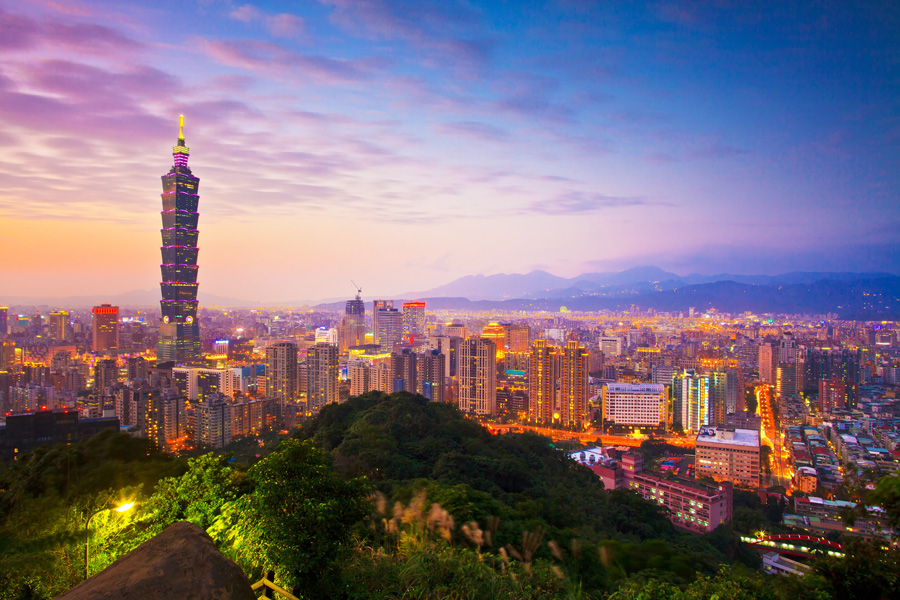[fshow photosetid=72157661269537241]
Lacking the chaos of Bangkok and Beijing and not quite on the same beaten track as Tokyo, Taipei is one of Asia’s big cities that are often overlooked by the traditional traveller. And that’s a shame because the city is full of art, culture, history and delicious food.
Having been under the influence of the Dutch, the Spanish, the Chinese and the Japanese, this small island off the coast of mainland China has taken the best of each culture and made it its own. Unlike its closest neighbour, the People’s Republic of China, Taiwan is a vibrant democracy and even people with little knowledge of the two countries will be able to discern a difference, perhaps not tangible, but a difference all the same.
Good Views
Taipei’s perhaps most famous landmark is the Taipei 101, the 508-metre bamboo-like structure that towers above the city and which held the title of the tallest building in the world for a number of years. For those who think visiting Taipei and not ascending the tower is akin to visiting Paris and not going up into the Eiffel Tower, there is an observation deck (much less crowded than the one in the Eiffel Tower, too) on the 88th and 89th floors as well as an outdoor deck on the 91th floor, which is open when the weather permits. But for a more wholesome view of the entire city – and Taipei 101 – head instead to Elephant Mountain. This is where all those iconic photos of the Taipei skyline are taken. Take the MRT to Xiangshan and follow the signs for a short walk to the trailhead.
Another classic view in Taipei is that from the steps of the Chiang Kai-shek Memorial Hall, located in Liberty Square. From the top of the 88 steps (the age of Chiang Kai-shek when he died) you can see the imposing National Theatre and Opera Hall as well as the intricate main entrance gate to Liberty Square. The memorial itself, while impressive and grandiose, is mocked for being the typical neo-classical style that Chiang Kai-shek ordered as a counterpart to the Cultural Revolution’s destruction of real classical culture in China.
About the Art
Taipei has a vibrant art scene, and established as well as underground venues actively promote and engage in various activities throughout the year. That’s good news for visitors because it means that pretty much regardless of when you visit Taipei, there is an art exhibition, a film or music festival or a carnival happening. One of the best times of the year to visit if you are looking for some great artsy pastimes, is October to December when pleasant weather means lots of outdoor art and cultural fairs. Art Taipei, one of the most established art shows in the art industry, takes place around this time and provides a great opportunity for both art connoisseurs and beginners to experience a wide range of art from Taiwan and around the region.
A must visit for those interested in art and culture is the Huashan 1914 Creative Park, located in the Zhongzhen and Xiemending area. Situated in a restored early 20th century wine factory, the park has become one of the hippest hangouts in Taipei with shops, galleries, cafes, restaurants, workshops, creative spaces and a cool, indie cinema showing Taiwanese as well as European films. Some of the shops and galleries are hidden between old halls, so make sure to get into every nook and cranny you can find.
Foodie’s Paradise
Few countries can lay claim to a street food culture as rich and diverse as Taiwan’s and Taipei is the heart of all the action. A good place to start is at the city’s many night markets where you can try Taiwan’s many specialties such as the infamous stinky tofu, a bowl of boiling hot beef noodles or a mountain of shaved mango ice. In fact, food in Taiwan is done so well that several food ventures have branched out and become international hits. Din Tai Fung is a good example. What started as a small dumpling restaurant in Taipei’s Dongmen district has become a worldwide franchise adventure with branches in Australia, China, Hong Kong, Indonesia, Japan, Korea, Malaysia, Singapore, United States, Thailand and Dubai. The Hong Kong branch even has a Michelin star. The dumplings are so popular that they create lines in several branches around the world. Another good example Hot Star Chicken, a simple fried chicken restaurant that proves that fried chicken is not just fried chicken.
Some of the best night markets to try are Shida, located in Daan district; Ningxia, located close to Zongshan MRT and Raohe, next to Yongchun MRT. Few of the vendors at Taipei’s night markets speak any English so pointing and gesturing will get you a long way. Just remember to bring an open mind and plenty of appetite.
Tips:
- The weather on Taiwan is unpredictable and a quick rain shower is never far away. Remember to bring an umbrella.
- Taipei’s MRT system is efficient, clean, easy to use and affordable. Single trip tickets are available but if you plan to use the MRT a lot, it’s easier to buy a pass that you can top up so as to avoid buying tickets every time you take the MRT.
- Taiwan is highly modern and it is not uncommon to find wifi in the most unusual places. Most cafes and restaurants will offer wifi free of charge, and even some 7-Elevens and shopping malls too. Don’t be surprised that if you look for free wireless networks at any given place, you will find several.

